Plus a lifer for me – a Snowy Plover at Bear River MBR yesterday. And an update on Dr. Talamy’s “What Do Birds Eat?” project.
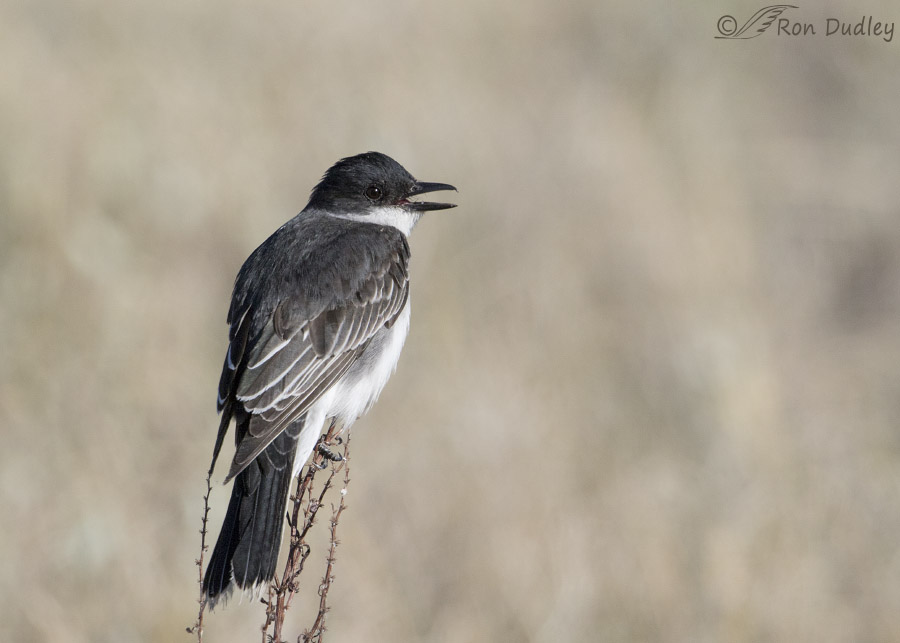
1/4000, f/6.3, ISO 500, Canon 7D Mark II, Canon EF 500mm f/4L IS II USM + EF 1.4 III Extender, not baited, set up or called in
Yesterday I photographed this Eastern Kingbird on the approach road to Bear River MBR. He exhibited some weird behavior that I’d never seen (I don’t know the sex but for the sake of convenience I’ll refer to it as a male). He was constantly opening and closing his bill during the entire 8 minutes I spent with him. He usually didn’t open it very far but he did it rhythmically and continually without pause. I estimated that he did it once every second which is about the respiratory rate of a bird this size according to some quick research I did.
It wasn’t “gular fluttering” that birds often use to keep cool in the heat because he didn’t keep his beak open during the process (it was constantly opening and closing) and he didn’t flutter his neck muscles (birds don’t have a diaphragm so that’s the method they use to create air flow during fluttering). Besides, it wasn’t hot – it was still in the 60’s F.
The bird did this for the entire 8 minutes and he did it…
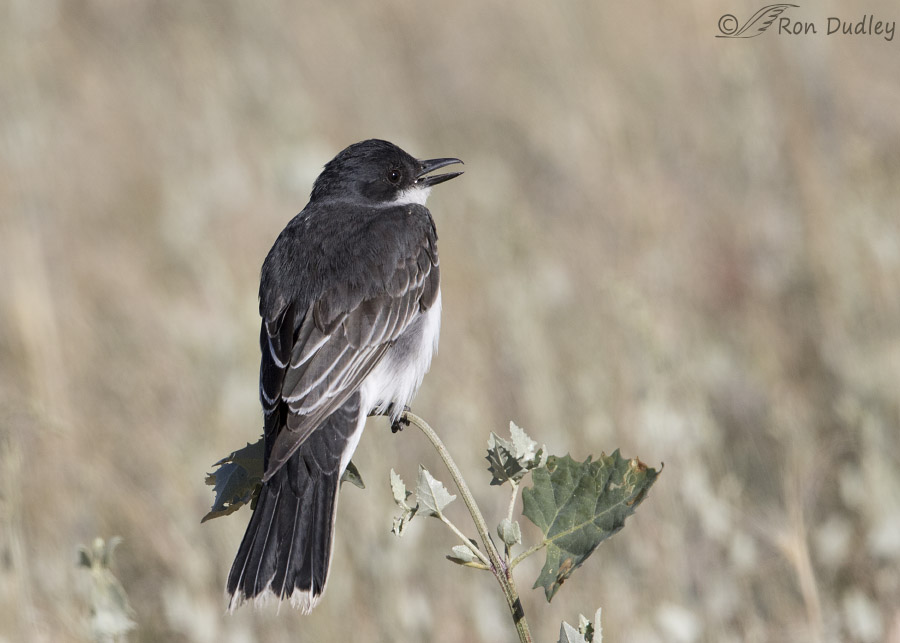
1/5000, f/6.3, ISO 640, Canon 7D Mark II, Canon EF 500mm f/4L IS II USM + EF 1.4 III Extender, not baited, set up or called in
on 4…
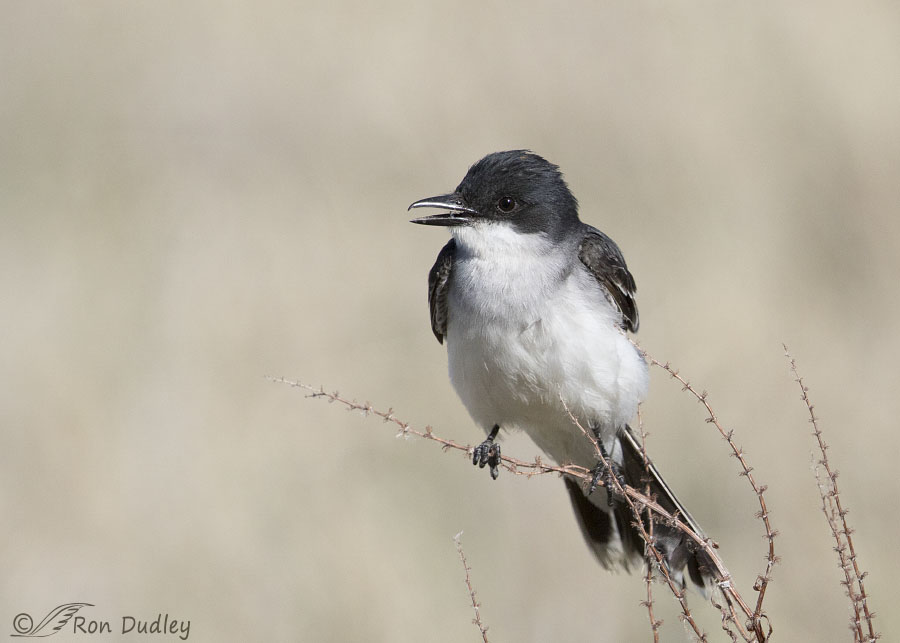
1/8000, f/6.3, ISO 640, Canon 7D Mark II, Canon EF 500mm f/4L IS II USM + EF 1.4 III Extender, not baited, set up or called in
different…
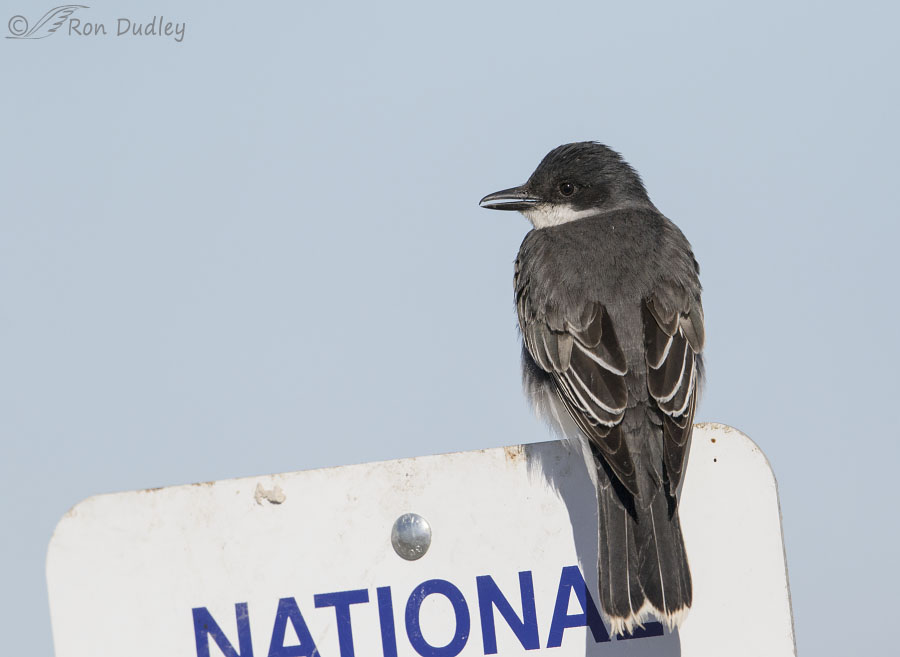
1/5000, f/6.3, ISO 640, Canon 7D Mark II, Canon EF 500mm f/4L IS II USM + EF 1.4 III Extender, not baited, set up or called in
perches. I was stymied about what I was seeing and I still am.
Ok, back to the third perch for a minute.
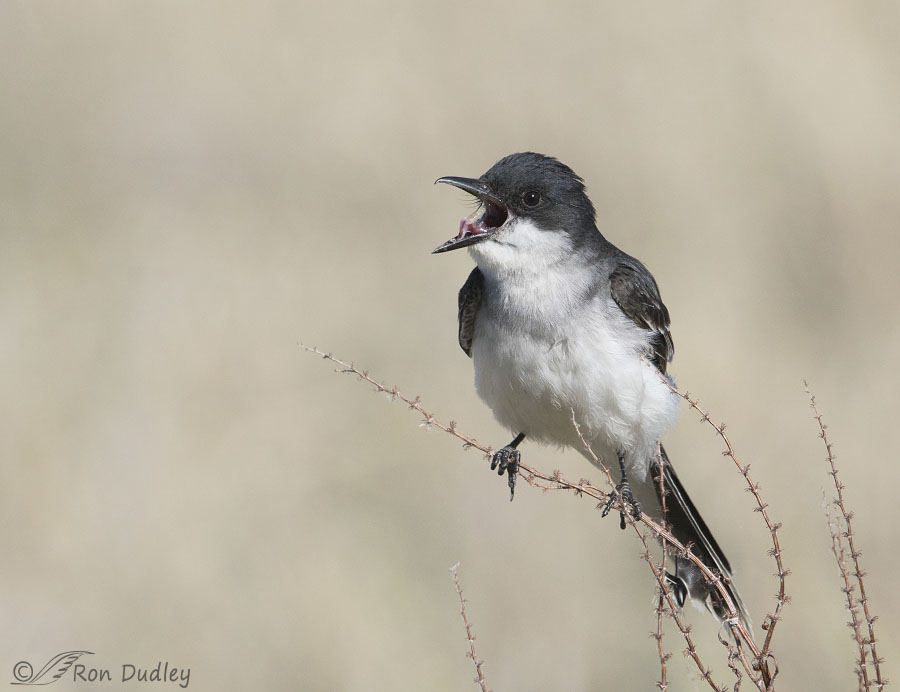
1/6400, f/6.3, ISO 640, Canon 7D Mark II, Canon EF 500mm f/4L IS II USM + EF 1.4 III Extender, not baited, set up or called in
While he was here he flew off after prey and caught an insect. He swallowed it (apparently) before I could get my lens back on him but soon he appeared to be retching. At first I wondered if he was trying to throw a pellet but I’m fairly confident that wasn’t the case. I’ve spent endless hours with kingbirds and photographed them throwing pellets several times. This was different.
My best guess is that he was having trouble breathing because of something caught in his throat and that might explain him (apparently) breathing through his mouth rather than his nostrils in the previous images. The presumed object might have blocked the openings to his nostrils in the back of his throat. But if that’s true, how did he (presumably) swallow the insect?
So I’m reaching for an explanation for a bird behavior I’ve never seen. I’ll probably never know and readers may wonder why I’m making such a big deal of it. Maybe you had to be there…
And I had some more excitement yesterday morning at Bear River.
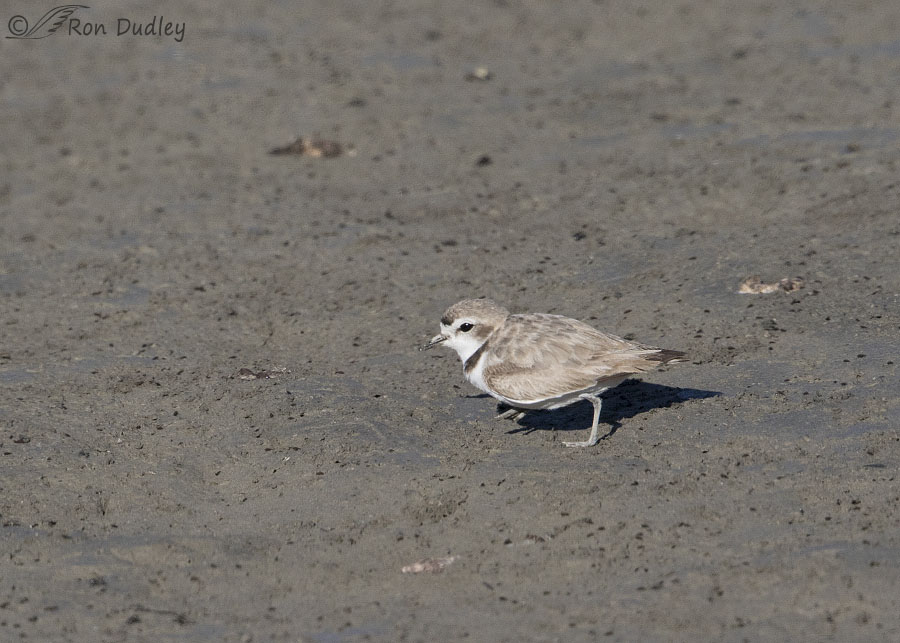
A “lifer” for me, a Snowy Plover! It was far away and I never got any quality images but it was a memorable experience nonetheless. I usually try to avoid the word “cute” but in my book these tiny birds certainly qualify for that overused distinction.
Ron
PS – I thought readers of yesterday’s post would be interested in some feedback I received from Dr. Doug Tallamy who leads the “What Do Birds Eat” project at the University of Delaware I featured in that post.
In an email to him I suggested that he would likely get many more photo submissions of birds with insects in their bills if his entomologists ID’d the insect for the persons submitting them. I told him that folks like “us” like to know that kind of thing. I was encouraged by his response as follows: “I am forwarding this to my grad student Ashley Kennedy who is heading up this project. Reporting back to interested photographers is a great idea if we can pull it off. I’ll talk to Ashley about it.”
And as a favor he ID’d the insects in yesterday’s post for me. The Yellow Warbler has a caddisfly in its bill (I should have known that one) and the Savannah Sparrow had snagged ” a beetle larva…it looks like an aquatic beetle, maybe a Hydrophilid, but I’m not sure how a savannah sparrow would capture one of those”.
From the value of his work to birds and from his prompt and generous response to me I get the definite impression that Dr. Tallamy is one of the good guys.
Note: I’m having computer problems so I may have to take it in for repair. If that happens I likely won’t be able to post for a few days so don’t be concerned. It also explains why I haven’t been able to edit this post carefully.
Update: My computer problem is “fixed” at least for now. I have to remember to clear my cache once in a while…


This makes me think it has a cratchety rachety insect leg stuck half up/half down and it is gagging…but maybe not since tied in with respiratory.Hope it gets relief though if in destress.Thanks for all your info here!
Diane, I think it’s quite possible it had part of an insect stuck back there.
The Eastern Kingbird has COPD.
Ok, I do not say that on any authority.
Linda and I saw what we feel confident was a Horned Lark about 30 miles south of Anaconda, Montana. The “horns” or tufts were very distinct, however, which we did not expect to see in this region–or should we not be surprised by that at this time of year? We are basing our question on Sibley.
Sadly, we have no picture.
Your thoughts?
Kevin, My Sibley shows them in MT year-round. They were the most common bird on our farm in Cut Bank, MT. As far as I know their horns can be erected any time of year.
Very interesting Kingbird behavior. I don’t usually think of birds as having problems with breathing or other such ailments – probably because usually when I watch birds they’re just fine and just being birds. Hopefully “he” is okay. Thanks for the update from Dr. Tallamy – it was a good sanity check for me. And congratulations on your lifer. That little guy reminds me a lot of Sanderlings, which I always enjoy watching on the beach.
I’ll bet many birds with respiratory problems crawl off to die before we ever see them, Susan. Thankfully this kingbird looked healthy in every other way and it was eating which is a good sign.
Oh, I KNEW I was forgetting something…and yet again, you’ve taught me something new about the red/yellow/orange of the Cedar Waxwing’s feathers! And what an interesting factoid! Thanks again for teaching me new things every day.
A factoid I can share is about diet affecting whether a goshawk’s eyes turn red or orange. OK, now that I’ve brought this up, I can’t remember the specifics, but it’s about diet in varying regions where they live.
There’s probably something else I’m forgetting, but you know how that goes. I’ve slept since then. Stuff falls out.
Didn’t know that about the Goshawk. Interesting…
Interesting suppositions about the Kingbird. I know redtails and Harris’ hawks have mucous and horses get boogers (I didn’t know that before moving here, but in all truthfulness, I never thought about it, either). However, I maintain that it’s not fair to get boogers if you don’t have fingers to pick your own nose, but I digress.
I just love Dr. Tallamy’s project and the grad student working on it. Sadly, I can’t help in this endeavor. Since I’m not much of a photographer, I rarely have my camera with me. Even if I did, I’d be hard pressed to capture a decent photo. I CAN tell you that birds around here eat a bunch of seeds and suet cakes–if I let them, they’d eat me out of house and home. The concept of flying pigs comes to mind
While I feel your computer-problems pain, I sure wish I could fix mine. But alas, no. It’s not even intermittent now, either. Wish the geeks would listen to me explain the problem instead of just ignoring me and moving along with their regular fixes that fix most things, but not this one. Alas, no.
Since my computer sent me over the edge of insanity, I’m in catchup mode. I needed to comment on your post about how ravens deal with their kids’ excrement. That’s another thing I never knew before (and didn’t pause to think about, either). Just another reminder that parenting ain’t as easy as it looks. I know I’d have failed miserably at the task so it’s good I never walked that path…LOL!
That Snowy Plover IS cute. End of that discussion…LOL!
And happy birthday Dick!! CELEBRATE this day!
I’ve had that happen before too, Laura. Computer techs to their “tuneup” but don’t fix my precise problem and than it just continues. Maddening as hell!
You do tend to capture some weird bird stuff, Ron. And if you don’t like “cute” for the Plover, how about “adorable?”
And if you don’t like “cute” for the Plover, how about “adorable?”
Yup, generally adorable works better for me, Marty. And it sure applies to that plover!
Outstanding pictures and some intriguing behavior, well done!
Thanks very much, Daniel.
I hope someone can solve that mystery for you (and us).
I would have thought ‘something caught in the throat’ but it swallowed the insect. Colour me clueless.
And hooray for a lifer, and a PC which is behaving. Which mine still isn’t – but it is a stinking intermittent problem so repair persons cannot assist.
Intermittent problems are the pits, EC. Computers, vehicles – pretty much anything electrical or mechanical, doesn’t matter. Good luck with yours!
Wonderful post Ron!
Yup, sounds like Dr. Tallamy is one of the good guys. Now lets see if it happens.
I would guess that your idea that the Kingbird was having trouble breathing, felt it had something blocking its airway is probably on the right track, but I’m guessing.
Congratulations on your life bird and it looks like a female.
Happy Birthday, Dick!
I think it’s likely a respiratory issue too.
Happy Birthday, Dick! Woo Hoo!
Thanks Marty, you know when one gets to my age, every day that I’m awake is a great day!!
Appears the Kingbird must have been having some respiratory issue to me……? Didn’t realized the end to their upper bill has a bit of a hook in in! The Plover is “cute” – only word for it!
The Plover is “cute” – only word for it!  Dr. Tallamy IS one of the good guys and, obviously, open to suggestion. Damn “computers” – great – when they work!
Dr. Tallamy IS one of the good guys and, obviously, open to suggestion. Damn “computers” – great – when they work!  Hope it’s nothing serious!
Hope it’s nothing serious!
Judy, I suspect that hook is perfect for snagging insects on the wing.
I think a respiratory issue is a strong possibility. It sure was strange to see!
Actually, with some help I think we’ve solved my computer problem. At least for now (gotta remember to clear my cache once in a while…)
Maybe this is far fetched, but is it possible that the Kingbird is making a sound that is out of our hearing range?
(I have some hearing loss, particularly at high frequencies, so personally I miss a lot of bird sounds)
I highly doubt it, D. It was too consistent for much too long. And it matched breathing rate perfectly.
Interesting KingBird information…I too am perplexed now. Those are the types of things that can sometimes keep me at the computer for hours and I do mean that. If not cute…how about delightful…but… It sure is cute though!
If not cute…how about delightful…but… It sure is cute though!  It was nice that you got the quick response that you did from Dr. Tallamy. It certainly is a great project.
It was nice that you got the quick response that you did from Dr. Tallamy. It certainly is a great project.
I think it’s a wonderful project, Kathy. And the winners will be birds!
I’ve wanted to make a trip down to coastal Georgia and Florida for a while now to search for plovers, and your plover shot does definitely help that itch. Another possible answer for what the kingbird may be going through could be allergies? Or an overproduction of mucous (If birds even have mucous that is)? I’d imagine it would be difficult to say the least for a bird to blow its nose to remove things stuck in there, but only a guess.
Xavier, now that I’ve actually seen one I fully understand your “plover itch”.
Your suggested explanations are two I didn’t think of. I just don’t know. Yes, I’m sure birds have mucus. They’d have to…